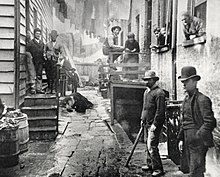George Appo

George Washington Appo (born in New Haven, Connecticut on July 4, 1856; died in New York City on May 17, 1930) was a pickpocket and fraudster whose manner of speech in a testimony became influential in depictions of criminals. George himself wrote an autobiography, unpublished, and became the subject of a book.[1] His father was a criminally insane Chinese American called "Quimbo Appo", Chinese name "Lee Ah Bow", while his mother, Catherine Fitzpatrick, was an Irish American. The origins of this criminal led a Louis Beck to present Appo as a story warning against "miscegenation".[2] Appo served time in various New York penitentiaries including Sing Sing, the Blackwell's Island Penitentiary, and the upstate penitentiary in Dennamora. In a biography by Timothy Gilfoyle, the prison system of New York in the later half of the 19th century is depicted as being based upon the spoils system and largely corrupt. In the description of Sing Sing, Gilfoyle outlines the stove manufacturing operation the inmates were forced to endure. Gilfoyle describes the penitentiary at Blackwell's Island (now Roosevelt Island) as having lax security, with inmates commonly escaping if they knew how to swim. Appo was also involved in a green goods scam in Poughkeepsie at one point in his life.[3]
Life
Childhood

George Appo's father was Lee Ah Bow, alias Quimbo Appo (ca. 1825–1912).[4] a migrant from the Chinese province of Zhejiang, who came to San Francisco in 1847 and was therefore one of the earliest Chinese migrants in this city. In 1849 Quimbo traveled to the East Coast of the United States as a gold prospector[5] , where he settled in Boston, New York and New Haven. In 1854 he married with Catherine Fitzpatrick, an Irish American of Dublin origin. In 1856, a few weeks after the birth of their child, George, the family moved to Five Points, Manhattan, a slum neighborhood. Here Quimbo worked as a tea house servant.[6][2]
See also
- Rebecca Salome Foster - advocate for the rehabilitation of prisoners who took on Appo as an assistant
References
- ^ "A Good Fellow and a Wise Guy" by WILLIAM BRYK in the August 9, 2006 edition of The New York Sun
- ^ a b Robert G. Lee (1999). Orientals: Asian Americans in Popular Culture. Temple University Press. pp. 81–82. ISBN 978-1-4399-0571-5. Cite error: The named reference "Lee" was defined multiple times with different content (see the help page).
- ^ Timothy J. Gilfoyle (2006). A Pickpocket's Tale: The Underworld of Nineteenth-Century New York. W. W. Norton Company. ISBN 978-0393329896.
- ^ John Kuo Wei Tchen: Quimbo Appo's Fear of Fenians. In: Ronald H. Bayor, Timothy J. Meagher (Hrsg.): The New York Irish. Baltimore, London 1996, S. 125–152.
- ^ Cite error: The named reference
Gilfoyle 3was invoked but never defined (see the help page). - ^ The New York Times v. 26. Dezember 1856 (PDF).
